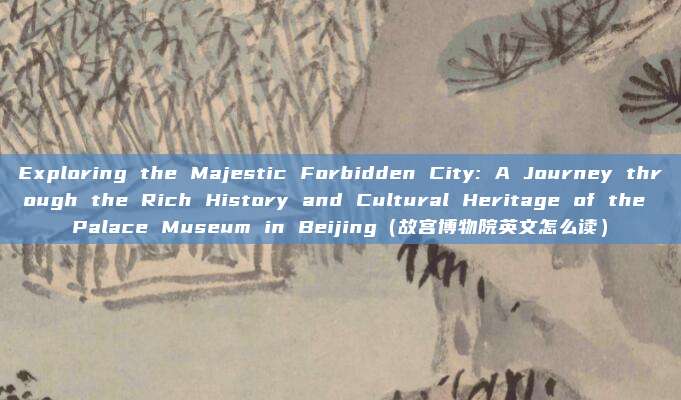Exploring the Majestic Forbidden City: A Journey through the Rich History and Cultural Heritage of the Palace Museum in Beijing(故宫博物院英文怎么读)
温馨提示:这篇文章已超过174天没有更新,请注意相关的内容是否还可用!
Introduction:
The Forbidden City, also known as the Palace Museum in Beijing, is one of the most renowned historical sites in the world. As the imperial palace of the Ming and Qing dynasties, this magnificent complex has stood as a symbol of Chinese power and culture for over seven centuries. In this article, we will delve into the fascinating history, architectural splendor, and cultural significance of the Forbidden City, providing you with a comprehensive guide to this awe-inspiring heritage site.
I. The History of the Forbidden City:
The construction of the Forbidden City began in 1406 during the reign of Emperor Yongle of the Ming Dynasty. It took 14 years to complete and was the largest palace complex in the world at that time. The complex has served as the imperial palace for 24 emperors over a period of nearly 500 years. In 1925, the Forbidden City was opened to the public and transformed into the Palace Museum, housing an unparalleled collection of art and artifacts.

II. Architectural Splendor:
The Forbidden City covers an area of 720,000 square meters and is surrounded by a 52-meter-high, 8.65-kilometer-long wall. The architectural design of the Forbidden City is an exquisite blend of Chinese traditional architecture and artistic mastery. The main buildings are arranged in an orderly manner, following the principle of “facing south,” which reflects the Chinese belief that the south is a symbol of prosperity and wealth.
III. Cultural Significance:
The Forbidden City is a treasure trove of Chinese history and culture. It houses a vast collection of paintings, calligraphy, ceramics, jade, and other artifacts. The collection, which totals more than 1.8 million items, is one of the most extensive in the world. The artifacts not only showcase the artistic achievements of ancient China but also provide valuable insights into the lives of the imperial family and the society of the time.
IV. Modern Management and Preservation:
In recent years, the Palace Museum has made great strides in the management and preservation of its heritage. The museum employs advanced technology to conserve the artifacts and make them more accessible to the public. Digital exhibitions, virtual reality tours, and other innovative methods have helped to attract more visitors and promote cultural exchange.
V. Conclusion:
The Forbidden City, or the Palace Museum, is a testament to the rich history, architectural grandeur, and cultural heritage of China. As one of the most visited tourist attractions in the world, the Forbidden City continues to captivate the hearts and minds of millions of visitors each year. Whether you are an art enthusiast, a history buff, or simply seeking a glimpse of ancient Chinese culture, the Forbidden City offers an unforgettable experience that will leave you in awe.
In 2019, the Palace Museum was listed as one of the top 10 most visited museums in the world, welcoming over 17 million visitors. This significant achievement highlights the importance of preserving and showcasing the cultural heritage of the Forbidden City for future generations. As a symbol of Chinese civilization, the Forbidden City will undoubtedly continue to inspire and enchant visitors from around the globe.
网站文章、图片来源于网络,以不营利的目的分享经验知识,版权归原作者所有。如有侵权请联系删除!





还没有评论,来说两句吧...